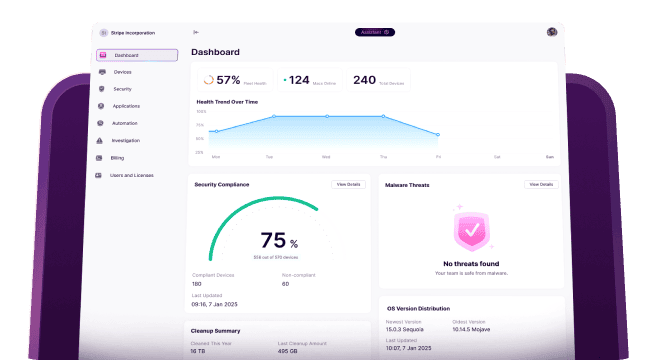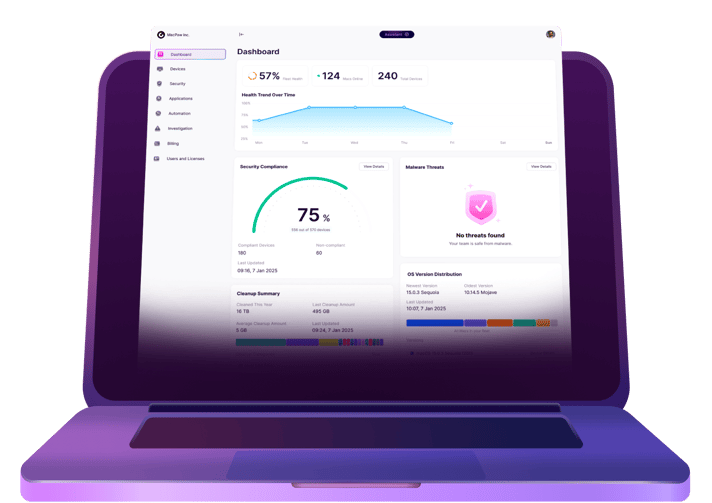Having the right tools for any job can make a world of difference. That’s true even of sysadmins. Without the right apps and systems in place, your team will likely be spinning their wheels and wasting their time troubleshooting simple issues. And that’s where automation comes in to save the day.
If you’ve been curious about sysadmin monitor tools or how you can automate some of your workflows but don’t know where to start, you’re in the right place. This article will go over some of the benefits as well as list out the best Mac sysadmin tools.
What are automation tools for sysadmins?
Maybe you’re just dipping your toe in this whole automation world, and you think it could benefit you and your IT team. The good news is you’re on the right track.
Simply put, automation will perform tasks and processes automatically. For sysadmins, these tools can include things like software deployment, patch management, and even endpoint protection.
Benefits of automation apps for sysadmins
There are a ton of perks to implementing more automation into your IT team’s workflows. Here are just a few:
- Time-savings. If your team doesn’t have to manually address small things like updating a virus definition database, that frees them up to work on other projects that can add value to your business.
- Monitoring alerts. Instead of having to look for issues and vulnerabilities in your network, automating software and hardware scans can alert you when problems are detected.
- Reliable security. You can rest easier knowing that all of your software is up to date when you automate your patch management systems.
Best sysadmin tools
Alright, I have to admit it. Maybe the use of “best” here is a bit of a misnomer because this is all very subjective. As you read earlier, finding the right tool for the job can make all the difference. That means there’s no one-size-fits-all solution that will help automate your workflows.
Sure, some apps are better than others. These are the best automation apps for what they do, but you’ll definitely want to demo them and see if they work for your team. At the very least, this should provide a solid jumping-off point in your search.
1. Jamf
When it comes to Macs in the corporate environment, Jamf is the premiere suite for software management and hardware inventory. It will manage end-user computers and servers alike. Making it easy for you to automate software updates and security patches.
Jamf inventories everything on your network. This means you can pull reports that include inventory to audit what hardware and software you have deployed. You can also set up a self-service tool to allow users to download and install approved software themselves. Saving your team valuable time having to manually push or install apps at any given time.
Learn more about Jamf.
2. Zapier
Need more app integrations? Zapier is a workflow automation tool that’s designed to do just that. It can talk to a wide variety of popular apps and platforms, acting as the middle-man passing information back and forth.
System administrators can look to Zapier to help them do everything from provisioning new users to managing security compliance. You could even use Zapier to help automate and manage your ticketing systems – taking yet one more thing off your IT team’s plates.
Learn more about Zapier.
3. Make
Similarly to Zapier, the platform Make can help you automate your app integrations. However, this tool might be better suited for teams that are working on external and more DevOps-based workflows. But nonetheless, it’s still a powerful tool that can help your team run more efficiently and effectively.
Learn more about Make.
There’s absolutely no question that automation tools can improve any team’s productivity. And, as a technology team, you’re likely to help other departments roll their own automation out. So, why not make an effort to help your own team become more efficient? Doing so will take care of all the tedious tasks your IT team has to put up with on a daily basis while freeing them up for projects that can actually add value to your company instead.
Any time you implement a new platform or workflow, there’s a significant learning curve and investment cost – both time and money. But it’s well worth it when it comes to automating tools for sysadmins. Let them take care of the bigger stuff. The things that will actually help your business excel and not just the ones that keep it running.
Hopefully, you’re feeling a little more at ease about adding some new automated workflows into your environment. I guarantee you’ll be surprised at how much easier they can make life for you and your team.








